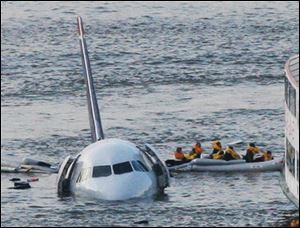
'Miracle on the Hudson' survivors mark 5 years
1/15/2014
Jan. 15, 2009, passengers in an inflatable raft move away from US Airways Flight 1549 that went down in the Hudson River in New York. Capt.
NEW YORK — The pilot, crew and passengers who were on board a plane that made an extraordinary landing on the Hudson River are marking the fifth anniversary of that remarkable day.
Capt. Chesley “Sully” Sullenberger III, First Officer Jeff Skiles and some passengers who were on US Airways Flight 1549 are expected to join some of the ferry crews who rescued them from the cold waters on Jan. 15, 2009.
The flight had just taken off from LaGuardia airport when a flock of geese disabled the engines. Sullenberger safely glided into a water landing. All 155 passengers and crew members were rescued in what became known as the “Miracle on the Hudson.”
Capt. Sullenberger often thinks back to those three long minutes on Jan. 15, 2009, that catapulted him into history. With both engines failing, Sullenberger and Skiles called on more than 50 years of combined flight experience to make split-second decisions in a crisis no one could have trained for.
The “Miracle on the Hudson” was hailed as unique in aviation history and launched the Danville, Calif., resident into the national spotlight. While “Sully” is looking forward to being in New York today for events with passengers and crew commemorating the fifth anniversary, he says he never wanted the attention he says has been “absolutely traumatic and overwhelming” for him, his wife, Lorrie, and two daughters, now 19 and 21.
Still, he quickly recognized his hero status presented a unique opportunity to advance causes he believes in. Since retiring in 2010, he’s kept up a busy, cross-country schedule as author, speaker, safety consultant and CBS News analyst.
But the most “logical good fit,” he says, has been as an advocate for patient safety in America’s hospitals. “It’s applying all the things we’ve learned for decades in aviation and making them transferable to medicine, where the need is so great,” he explained in a phone interview last week.
Preventable medical errors kill anywhere from 200,000 to 400,000 people each year, according to a 2013 study in the Journal of Patient Safety, making medical errors the third leading cause of death in the United States, behind heart disease and cancer. Even the 200,000 figure is “equivalent to three airline passenger planes crashing a day with no survivors,” Sullenberger said. If anywhere near that number of people were dying each year in air disasters, planes would be grounded and a presidential commission launched to address the situation, he said.
Like aviation, medicine is a highly technical and complex profession with most errors caused by individual error, poor communication, defective equipment or faulty systems.
But aviation has dramatically improved its safety record over the past few decades; the last air disaster in the United States with major loss of life was in November 2001, Sullenberger said. Gone, too, are the “bad old days” when captains ruled cockpits through arrogance and personal whim, he added. Airlines now run according to standard safety practices. With a somewhat flattened hierarchy, captains and crews are expected to work together as teams and share a sense of responsibility.
“Captain Sullenberger highlights the importance of having an expert team rather than a team of experts,” said Peter Pronovost, director of Johns Hopkins Medicine’s Armstrong Institute for Patient Safety and Quality.
Another supporter of Sullenberger’s advocacy is physician Atul Gawande, author of “The Checklist Manifesto.” Gawande draws the same parallel between aviation and medical safety and singled Sullenberger and his crew’s actions on Flight 1549 for their “admirable adherence” to their training and safety checklists.
Sullenberger said he would “amplify” Gawande’s idea to say checklists work best within cultures with effective leaders and front-line employees who feel safe to speak up about concerns.
“That doesn’t exist in medicine,” Sullenberger said.
As captain, one of Sullenberger’s checklist items was to hold crew briefings before each flight, because members often have not worked together before. Sullenberger met his co-pilot three days before Flight 1549, “but to see us in the cockpit that day, you would have thought we had been flying together for years.”
Sullenberger and other patient safety advocates have called for the creation of a national agency to oversee health care, one that would investigate certain hospital deaths in order to identify systemic failures and prevent recurrence. Such an agency could apply a non-adversarial, “root cause” analysis to situations such as the death of 13-year-old Jahi McMath at Children’s Hospital Oakland, in much the same way that the National Transportation Safety Board analyzes transportation accidents and prescribes possible solutions.
Sullenberger says there has been less urgency to reduce medical errors because the deaths occur individually in a fragmented system where there are “islands of excellence within a sea of system failure,” he said. He concedes that reforming aviation safety is simple compared to health care, which is highly politicized among industry leaders and representatives on Capitol Hill.
“I guess I’m the eternal optimist,” he said. “I think in our society, as with every other crisis it has faced, whether it’s slavery or seat belt use or smoking, we eventually do the right thing. The question is when. In 20 years, when we’ve lost 4 million more people to preventable deaths? My vote is to do it now.”